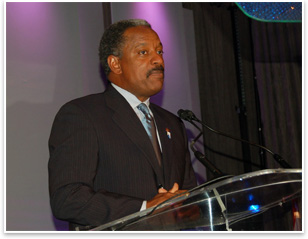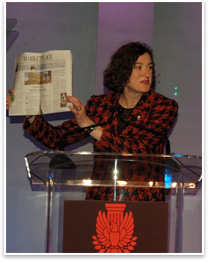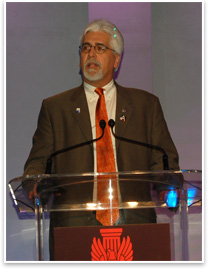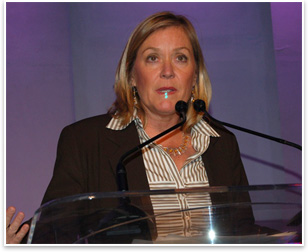
|
Grassroots 2007 Highlights “Celebrating the Past, Designing the Future”
Sustainability rules the day; Congress calls for Architecture Week proclamation Summary: “Welcome to Washington. Welcome to Grassroots 2007 and the opening session of the AIA’s annual Leadership and Legislative Conference,” said AIA Executive Vice President and Chief Executive Officer Chris McEntee as she opened the Institute’s annual event for 800 AIA leaders on February 7 in the nation’s capital. McEntee first focused participants’ attention on the press conference that took place earlier that day, when Congressman Earl Blumenauer (D-Ore.), revealed the people’s choice of the top 150 buildings of America’s favorite architecture. That public survey kicked off AIA150, the Institute’s sesquicentennial celebration, and demonstrates, McEntee says, the public’s passion for architecture.
Out of listening to all constituencies of the AIA came a new mission statement: “The American Institute of Architects is the voice of the architectural profession and the resource for its members in service to society.” With that mission in hand, the AIA’s Strategic Planning Committee created a bold, far-reaching plan, that was both informed by and expressive of the AIA’s core values, McEntee explained, values that have not changed in intent for 150 years. Characteristics of the AIA’s 2007–2009 Strategic Plan include a commitment to pursuing innovation, leveraging the Institute’s strengths, being results-driven, and using communications tools to foster transparency in member communications. “Throughout Grassroots we will have many opportunities to talk about the strategic plan—what it is and how it’s a resource for each of us in whatever way we exercise our leadership on behalf of AIA members everywhere,” McEntee concluded.
“Resolved by the House of Representatives (the Senate concurring), That it is the sense of Congress that the contributions of the architectural profession should be recognized and celebrated during ‘National Architecture Week,’ and Congress requests that the President issue a proclamation calling upon the people of the United States and interested organizations to observe such week with appropriate ceremonies and activities.” “On behalf of society, few professions have more power to help our planet avoid catastrophic consequence than you and I, and the nearly 80,000 men and women we represent, Stewart said. Thanks to the Board’s adoption of targets for reductions in buildings’ fossil fuel use, attention has increasingly focused on the role architects and architecture can play in mitigating society’s impact on climate change. “We need to ally with like-minded constituencies if we are to achieve results. We can’t do it alone,” Stewart concluded. “That’s why we’ve come to Washington.”  Allying on the message of sustainability Allying on the message of sustainabilityAIA First Vice President and Grassroots Chair Marshall Purnell, FAIA, carried forth the sustainability message. “We’ve got to go beyond talking at the issue,” he declared. “We’re obligated to lead by our actions, not our tongues. And lead we will!” He used the Grassroots conference itself as an example, which stressed eliminating excessive amounts of paper, and printing on paper with recycled content and on both sides of all handouts. Purnell also addressed the importance of the conference participants’ upcoming trip to Capitol Hill. “The difference between us and lobbyists is huge: Their leverage of choice is money; ours is votes,” he said. “The good . . . no, the great news is that unlike some who come to the Hill, we’re not here to advocate self interest; our issues truly serve the public good, which legally, ethically, and historically we are bound to do.”
Callahan pointed out that the built environment is the single largest energy-using sector in the country. “That’s why we’re so excited to be allied with AIA.” I can’t think of another group that can help us promote sustainability than the AIA, she said. Echoing Purnell’s message, Callahan stressed putting words into actions. Some of the actions she believes would be more effective are new building codes, standards—such as the AIA 2030 Challenge, Energy Star, LEED® building certification, and ASHRAE standards; and extending the 2005 Energy Act, tax incentives, and passing the Energy Act currently before Congress. |
||
Copyright 2007 The American Institute of Architects. All rights reserved. Home Page |
||
news headlines
practice
business
design
For more on Grassroots happenings, visit the AIA Web site.
Captions:
1. McEntee shows Grassroots participants the February 7, “front-page, above-the-fold in the Marketplace section” Wall Street Journal article that featured announcement of the 150 Best Buildings public survey.
2. Stewart emphasized the role architects and architecture can play in mitigating society’s impact on climate change.
3. Purnell highlighted the importance of making our views known on Capitol Hill and of allies in our search to serve the public good.
4. Callahan explained the Alliance to Save Energy, and how architects are well positioned to effect sustainability.
Photos by Douglas E. Gordon, Hon. AIA.

 Listening leads to strategies; strategies, to action
Listening leads to strategies; strategies, to action Proclaiming Architecture Week
Proclaiming Architecture Week Purnell then introduced
Purnell then introduced